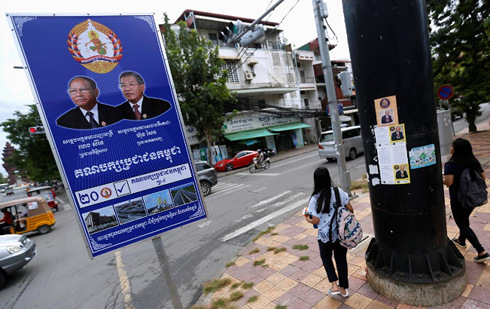(VOVWORLD) -8.3 million Cambodian voters will go to the poll this Sunday to elect 125 new members of the National Assembly. This will be the 6th National Assembly election in Cambodia since the first multi-party election was held in 1993 under the United Nations auspices.
 Cambodian voters will cast their ballots to elect members of the 6th National Assembly on July 29, 2018. (Reuters) Cambodian voters will cast their ballots to elect members of the 6th National Assembly on July 29, 2018. (Reuters) |
There are 60 political parties in Cambodia but 10 run for elections on a regular basis.
Most parties’ campaign pledges this year have centered around socio-economic development, human resource training, employment, and fighting corruption. The ruling Cambodian People’s Party (CPP) of Prime Minister Hunsen promised to solidify national unity, respect the Constitution, protect the monarchy, promote democracy, freedom, and social equality, safeguard independence, sovereignty, peace and national security, secure a growth rate of 7%, and reduce poverty 1% annually.
The CPP holds 68 seats or 55% of the total seats in the current National Assembly, enough to establish a government. Under the CPP’s leadership, Cambodia has enjoyed annual economic growth of 7.7% over the past two decades and is considered a new economic tiger in Asia.
Per capita income rose from 1,000 USD in 2013 to 1,500 USD in 2018. The poverty rate dropped from more than 53% in 2004 to 13% in 2016, surpassing Cambodia’s target set in the Millennium Development Goals. Cambodia’s public debt is among the lowest in the region. According to World Bank forecast, Cambodia’s economy will grow 7% in the 2018-2019 period. In the first half of this year, the country attracted 630 million USD in Foreign Direct Investment and recorded a import-export revenue of 8.3 billion USD. In the first quarter, it welcomed 1.7 million foreign tourists, up nearly 2% against last year.
The Cambodian government has maintained a foreign policy of neutrality, coexistence in peace, and non-interference in other countries’ internal affairs. Cambodia aims to cooperate with neighboring countries in completing border demarcation and the planting of border markers to ensure border areas of peace, stability, friendship, cooperation and development.